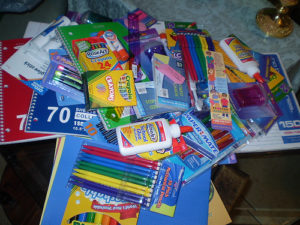 I can’t believe it’s almost the start of another school year, which means time to gear up for the back-to-school madness. When I was younger, I loved shopping for school supplies with my dad. I would always try to convince him that I needed a particular new and trendy accessory in order to succeed academically, and he would often reply that we already had one at home. He was a stickler on the basics, and on my finding an organizational system that worked well for me.
I can’t believe it’s almost the start of another school year, which means time to gear up for the back-to-school madness. When I was younger, I loved shopping for school supplies with my dad. I would always try to convince him that I needed a particular new and trendy accessory in order to succeed academically, and he would often reply that we already had one at home. He was a stickler on the basics, and on my finding an organizational system that worked well for me.
Jessica Lahey chronicled some of my tips in her back-to-school piece in the New York Times Motherlode column entitled, “Simple Solutions For Back-to-School Organization.“ She discussed some of my general ideas, like reinforced binder paper being a great upgrade, and my preferences, like single binders for each subject when possible. She also cited my first book, That Crumpled Paper Was Due Last Week: Helping Disorganized and Distracted Boys Succeed in School and Life.
I try to avoid reading the comments section, but I wanted to see what people were thinking – the article was shared widely, and people had opinions (!). The majority of protesters questioned the single binder for each subject preference – if a student had eight classes, how could that all fit in a backpack? And, it would give more binders to lose, right? Some also questioned the size of the binders (1” to 1.5”) but again, it is all variable on a student’s particular needs.
For high school students who have four or five classes that each involve a great deal of paper and projects, we often find having a single binder for each subject so that every subject is compartmentalized and avoids co-mingling, more commonly known as the History handout being lost in the Spanish section. Many high school students have block scheduling, so they only have 3-4 classes in one day, and compartmentalizing helps with focus and streamlining efforts.
But, for middle school students with eight classes everyday, having a single binder for each subject might seem overwhelming, so we often work together and create a customizable solution. Some have a single binder for the class that has the most work (math, for instance) and then have another binder that combines two to three subjects with separate tabs. Others do something altogether different.
Much of our work today at Green Ivy involves helping students, faculty, and parents become more organized, less stressed, and more focused on living less “busy,” more intentional lives. We can all be busy all the time, but simplifying our experiences creates pockets of opportunity for creation, collaboration, and communication in ways we often overlook.
Which brings me back to school supplies – we often overthink it. Bottom line: we need to continue encouraging students to find a system that works for them. My books are full of practical tips that have worked for thousands of students, but every young person is unique, and helping them find a system that empowers them to feel confident in their abilities is the most important part of the organizational process.
In the end, it’s all just a process. Here’s to another great year!

